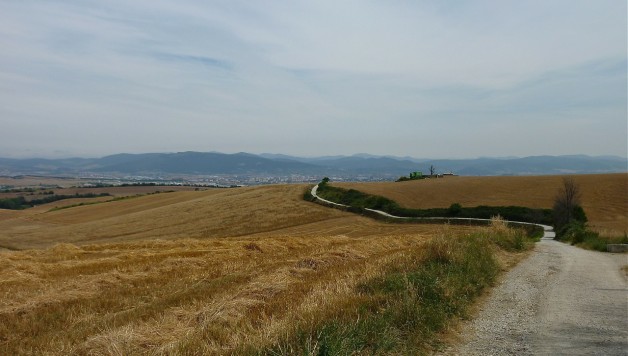The Most Popular Pilgrimage Road
Camino de Santiago – The Way of St. James is the most popular pilgrimage road through Europe to the Spanish town of Santiago de Compostela to the tomb of the Apostle James. For hundreds of years, pilgrims from around the world have been walking around Camino to worship the relics of the saint; however, in our time, the Path has ceased to be religious and has become Spain’s main walking route, having managed not to lose its mysticism and near-philosophical meaning. No matter what religion you profess, everyone can follow this route. Today Santiago Ways travel agency proposes many opportunities to see the breathtaking nature from Portugal to Spain.
The Northern Route
Camino del Norte or the Northern Route – almost completely passes along the picturesque coast of Northern Spain along the Bay of Biscay and the Atlantic, and further through the mountains, passing ancient Lugo, to the pilgrim capital Santiago de Compostela, where, according to legend, the relics of St. James rest. This path leads along deserted scenic mountain paths from one locality to another, connecting the cities in a long chain, like pearls in a necklace.
Along the road we will be accompanied by unique monuments of medieval architecture, statues of pilgrims, centenary churches and friendly pilgrims. We can also enjoy seafood and fruits.
The path of Santiago is also called the Way of the Stars. It is like a projection of the Milky Way leading to the only cherished goal. From the first centuries of Christianity, pilgrims rushed to the Holy Apostle. In the 12th century, Pope Calixtus II granted pilgrims absolution for all sins.
The French Route
The French Route is the most popular and crowded route of the Camino de Santiago, with a very developed infrastructure Therefore, it is considered a good option for beginners, although it is the longest of all, about 700 km.
The French Way or Camino Francés, is very rich and diverse in terms of culture and nature: starting in the French Pyrenees, it passes through the hills and cliffs of Navarre, the vineyards of Rioja, the endless fields of Castile-Leon, crosses two more mountain ranges and ends among the evergreen hills of Galicia.
On the way, we will pass through Pamplona, Logroño, Burgos, Leon, Astorga, Ponferrada, as well as other smaller cities, which are often equally important in the historical and cultural sense of the city. At each stage there will be something noteworthy: an ancient church, a monastery or a museum.
The English Route
The English Way is extraordinarily beautiful – nature and culture are in balance. It combines a variety of landscapes: ocean expanses and bays, rivers and forests, hills and plains; it passes through small villages and through cities known since the Middle Ages. The peculiarity of this path is its length, it is 85-120 km, which is very small.
This is the shortest of all routes to Santiago de Compostela. Until now, he remains one of the most crowded: during the whole day you can meet one or two pilgrims or, on occasion, a group of pilgrims.
The Camino Portugues
Portugues Camino along the coast, conventionally divided into three parts consisting of successive stages. The first part begins in Lisbon, crossing half of Portugal and ends in the city of Porto. The second, continues from the northern capital of Portugal to the Minho River – which is the natural border between Spain and Portugal. Then, already the final part of the route, passes through Spanish Galicia – right up to the “house of Santiago”.
Therefore, for some pilgrims, the city of Porto may be a continuation of the already begun route in Lisbon, while for others it will only become a place of departure. The length of the way is about 260 km from the city of Porto to the Cathedral of St. James. But there are 260 unique kilometers! The kilometers, annually gaining phenomenal popularity.
The Camino Finisterre
The Camino Finisterre is located on the shores of the Atlantic Ocean, here the pilgrims complete their journey at Cape Finisterre and find here the latest answers in the philosophy of the Path.
Greco – Roman geographers and historians have given special philosophical significance to the place. For centuries, they observed how the sun plunged into the ocean, beyond which the horizon. Thus, this “farthest point”, where the enlightened inhabitants of the Mediterranean rarely visited, was called Finisterre (Fin de la Tierra). Subsequently – until the discovery period, this territory was also a deserted corner of the continent, which continued to correspond to the name. Today this lonely place, especially in the cold season, continues to symbolically confirm its “remoteness” from the civilized world.
So what’s the point of going after the Santiago to the coast?
- The first is that by reaching here you can get two more letters for the next “victories of the body and spirit over the hardships of life.”
- The second is to cool your worn legs or even plunge into the cool waters of the ocean and get emotions of joy and relief.
- Third, after waiting for sunset, to hypnotize yourself with the sun disc hiding in the expanses of the Atlantic and feel what the Celts and the Romans were content with.
- The fourth is to see with my own eyes this mystical “Edge of the Earth” and take a picture with a “Zero Kilometer.”
The Camino Primitivo
The Camino Primitivo is one of the most beautiful, challenging, and rewarding sections on the Camino de Santiago. It crosses a mountain range at 1100m above sea level where you will witness spectacular views of the Embalse de Salime (artificial lake), the River Navia and of course the surrounding mountains!
Camino Primitivo starts in Oviedo, passes through Spanish Asturias and Galicia, connects with Camino Frances and leads to the constant final point of all pilgrims – Santiago de Compostela.
The total length of the route varies, depending on the sources, from 310 to 340 km. His progenitor is King Alfonso II, who walked this road to the supposed tomb of the Apostle James as early as the 9th century. This route is considered to be the oldest existing one today.
The Silver Way
From south to northwest towards Santiago de Compostela – Silver Way ( Via de la Plata) leads the pilgrim through 5 Spanish provinces, allowing you to see the country from the inside. The journey is difficult , so it is best to go on this road to the second or third Camino, gaining experience in any other pilgrimage.
In ancient times in the era of the Roman Empire, Via de la Plata was the road that connected the south with the seaports in the north (delivery of silver and gold). Now the Silver Path is one of the variants of Camino Santiago, which is a popular religious tourist route for pilgrims from around the world. Camino de la Plata allows you to visit 5 provinces in Spain:
- Andalusia;
- Extremadura;
- Castile and Leon;
- Asturias;
- Galicia.
The Silver Way leads the pilgrim through iconic places and old roads – if you wish, you can see a lot of Roman buildings and medieval structures.













